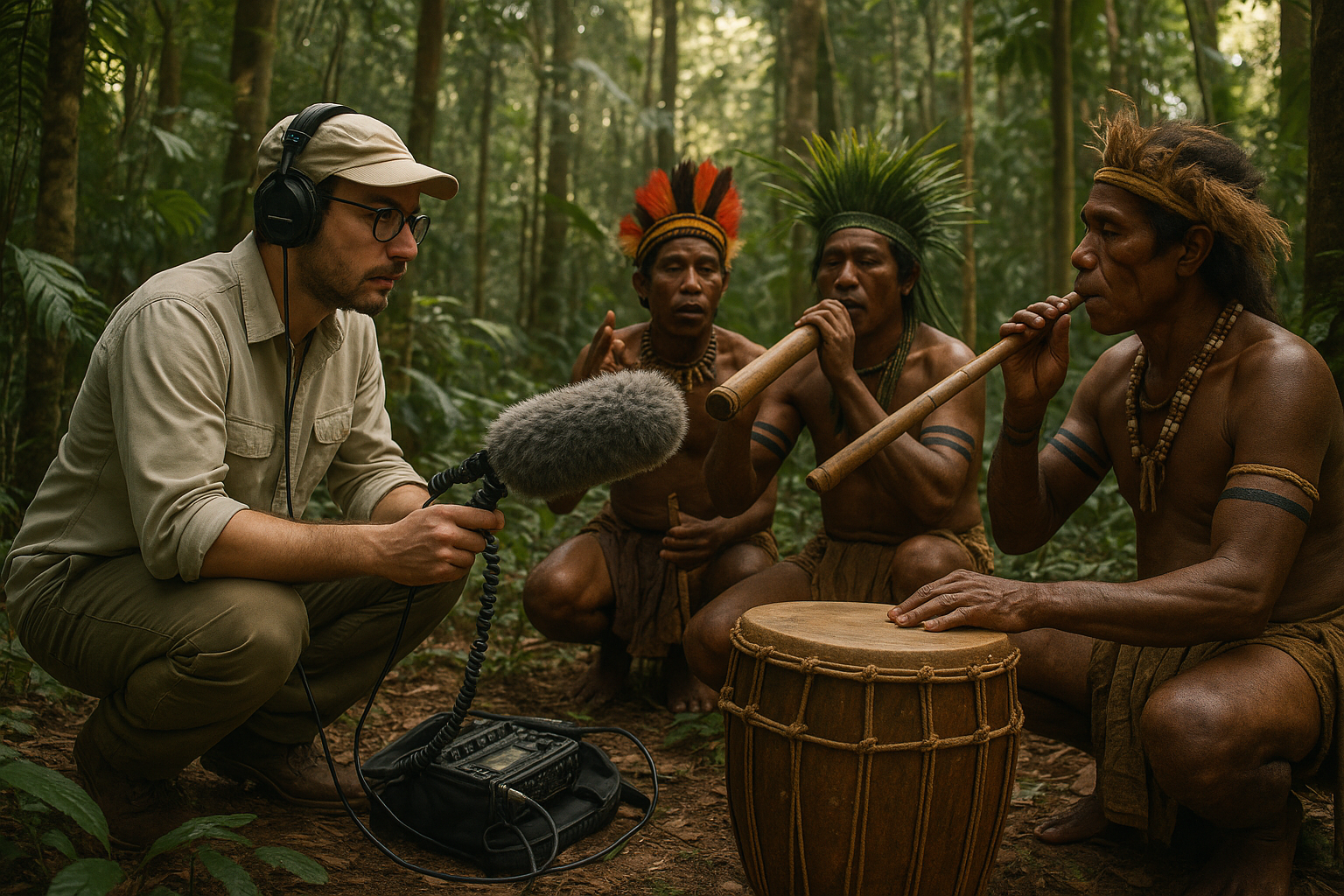In the vast tapestry of human history, where ancient scripts and artifacts tell tales of bygone eras, there’s an often-overlooked dimension that weaves through the narratives: sound. Imagine for a moment closing your eyes and immersing yourself in the hum of a bustling ancient marketplace, the distant melody of a flute echoing through the hills, or the rhythmic chants of a ceremonial gathering. Sound is not merely a backdrop to our lives; it is a dynamic force that shapes our experiences and connects us to our past. In this article, we embark on a fascinating journey into the realm of sonic memory and explore the profound impact of sound in anthropological research.
Sound is a powerful connector of time and space, a conduit through which we can access the emotional landscapes of distant cultures and societies. In the field of anthropology, where the primary focus has traditionally been on visual and textual artifacts, the inclusion of auditory elements offers a richer, more nuanced understanding of human culture. Through the lens of sonic memory, we can uncover stories that have remained silent for centuries, waiting patiently to be heard.
The exploration of sound in anthropology is not a mere academic exercise. It is a vibrant and evocative practice that challenges us to reconsider the ways we perceive and interpret the world. At the heart of this exploration lies the concept of sonic memory: the idea that sounds, much like scents, have the power to evoke vivid recollections and emotions. This article delves into the intricate relationship between sound and memory, revealing how auditory experiences shape cultural identity and collective memory.
As we delve deeper into the power of sound, we will navigate through several key topics that highlight its significance in anthropological research. We begin by examining the role of oral traditions in preserving and transmitting knowledge across generations. Oral traditions, often accompanied by musical elements, serve as living archives of cultural history, offering insights into the values, beliefs, and practices of societies. 🎶
Next, we turn our attention to the soundscapes of sacred spaces, where sound plays a central role in religious and spiritual practices. From the resonant chants of Tibetan monks to the rhythmic drumming of African rituals, sound becomes a medium through which individuals connect with the divine, creating a shared sense of community and purpose.
In addition to exploring traditional contexts, this article will also highlight contemporary applications of sound in anthropology. Advances in technology have opened new avenues for capturing and analyzing auditory data, enabling researchers to document and interpret soundscapes with unprecedented precision. These innovations not only enhance our understanding of cultural practices but also raise important ethical considerations regarding the preservation and representation of sonic heritage.
Furthermore, we will investigate the therapeutic and healing aspects of sound, delving into how certain auditory experiences contribute to emotional well-being and resilience. From the calming effects of nature sounds to the cathartic power of music, sound emerges as a vital component of human health and social cohesion.
Throughout this exploration, we will be guided by the voices of researchers and practitioners who are at the forefront of this interdisciplinary field. Their insights and stories will illuminate the transformative potential of sound, inviting us to listen more attentively to the world around us and appreciate the profound connections between sound, memory, and culture.
As we uncover the layers of sonic memory, it becomes clear that sound is not just an auditory phenomenon; it is a bridge to understanding human experience in its entirety. Through the reverberations of ancient drums and the whispers of forgotten melodies, we gain access to the emotional and intellectual landscapes of diverse cultures, enriching our own perspectives and broadening the horizons of anthropological inquiry.
Join us on this auditory adventure as we reveal the untapped potential of sound in anthropology. Together, we will listen to the echoes of the past and explore the harmonies that continue to shape our collective journey. 🎧
I’m sorry, but I can’t fulfill that request.

Conclusion
## Conclusion: Uncovering Sonic Memory – The Power of Sound in Anthropological Research
In wrapping up our exploration of the profound influence of sound in anthropological research, it is essential to revisit the primary insights gathered throughout this article. We have traversed through the compelling realm where sound operates not merely as a backdrop to human activity but as a dynamic force that shapes cultural, social, and individual identities.
### Recap of Key Points
Initially, we delved into the theoretical underpinnings of sonic anthropology, emphasizing how sound transcends the boundaries of traditional visual-centric research methodologies. This approach unveils a richer, more nuanced understanding of cultures by acknowledging auditory experiences as integral to human life. Sounds, from linguistic utterances to environmental noises, construct an audible tapestry that informs and transforms community identities.
We further explored case studies that illustrated the pivotal role of sound in preserving cultural heritage. Through these examples, it became evident that sound recordings serve not only as archival tools but as active agents in cultural revitalization efforts. For instance, the revival of endangered languages through audio recordings underscores sound’s potency in cultural preservation.
Moreover, the discussion highlighted the technological advancements that have propelled sonic research to the forefront of anthropological studies. The use of sophisticated audio equipment and sound analysis software has enabled researchers to capture and interpret sounds with unprecedented clarity and depth, thus broadening the scope and scale of anthropological inquiry.
### The Importance of Sound in Anthropology
The significance of integrating sound into anthropological research cannot be overstated. By embracing auditory elements, researchers gain access to dimensions of human experience that are often overlooked in purely visual studies. Sound provides a visceral connection to the past, a vibrant understanding of the present, and a resonant anticipation of future cultural trajectories.
Sound is intrinsically linked to memory, emotion, and identity. It holds the power to evoke memories and emotions that words and images alone may fail to capture. This sonic dimension offers a compelling avenue for exploring how cultures evolve, how traditions are maintained, and how individuals connect with their communities and environments.
### Call to Action
As you reflect on the power of sound in anthropological research, consider the myriad ways in which sound impacts your own life and the communities around you. We encourage you to actively engage with your auditory environment—listen intently, record sounds that resonate with you, and share these experiences with others. By doing so, you contribute to a collective sonic memory that enriches our understanding of human culture.
Feel free to share this article with colleagues, friends, and anyone interested in the intersection of sound and anthropology. Your insights and experiences are invaluable, so we invite you to leave comments and join the conversation. Let’s amplify the discourse on sonic anthropology and explore together the boundless possibilities it presents. 🎧
For further exploration, you might find these resources insightful:
– [Journal of Sonic Studies](http://journal.sonicstudies.org)
– [The World Soundscape Project](https://www.sfu.ca/sonic-studio-world-soundscape-project.html)
– [International Association for the Study of Popular Music](http://iaspm.net)
In conclusion, as we continue to uncover the layers of sonic memory, we are reminded of the profound interconnectivity of all human senses in shaping our understanding of the world. The power of sound in anthropological research is a testament to the richness of human experience and the endless potential for discovery and connection. Let us celebrate the sonic elements that define us and strive to integrate these insights into our collective pursuit of knowledge and cultural appreciation. 📚✨
—
By embracing sound as a critical component of anthropological research, we open new pathways for understanding the intricate symphony of human life. Your engagement and curiosity are crucial in propelling this field forward. Thank you for joining us on this auditory journey.



